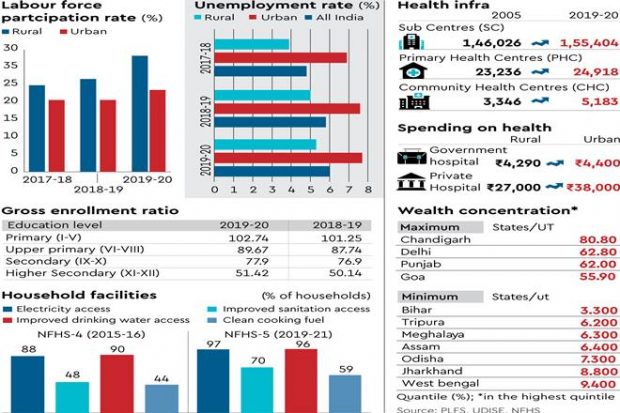Focus: GS II- Polity and Governance
Why in News?
Recently, the ‘State of Inequality in India’ Report was released by the Economic Advisory Council to the Prime Minister (EAC-PM).
About State of Inequality in India Report
- The report gathers information on inequities in health, education, household factors, and the labour market. Inequity in these areas makes the population more vulnerable and leads to a spiral of multidimensional poverty.
- The research broadens the narrative on inequality by providing a complete analysis that shapes the country’s ecosystem of diverse deprivations, which has a direct impact on the population’s well-being and overall growth.
- The data for the report comes from the Periodic Labour Force Survey (PLFS), the National Family and Health Survey (NFHS), and the United Information System for Education Plus.
The report consists of two parts – which looks at five key areas that influence the nature and experience of inequality.
- Economic Facets
- Socio-Economic Manifestations
Five Key Areas:
- Income distribution
- Labour market dynamics
- Health
- Education
- Household characteristics.
Highlights of the Report
- Wealth concentration: Urban areas have a 44.4% wealth concentration in the highest quintile (20%) compared to a meager 7.1% concentration in rural areas.
- Unemployment rate: India’s unemployment rate is 4.8% (2019-20), and the worker population ratio is 46.8%.
- In 2019-20, among different employment categories, the highest percentage was self-employed workers (45.78%), followed by regular salaried workers (33.5%) and casual workers (20.71%).
- Health infrastructure: In the area of health infrastructure, there has been a considerable improvement in increasing the infrastructural capacity with a targeted focus on rural areas.
- From 1,72,608 total health centres in India in 2005, total health centres in 2020 stand at 1,85,505.
- Household facilities: By 2019-20, 95% of schools would have functional toilet facilities on the school premises (95.9% functional boy’s toilets and 96.9% functional girl’s toilets).
- According to the National Family Health Survey-5 (2019-21), 97% of households have electricity access, 70% have improved access to sanitation, and 96% have access to safe drinking water.
- Education: The Gross Enrolment Ratio has also increased between 2018-19 and 2019-20 at the primary, upper primary, secondary and higher secondary.





